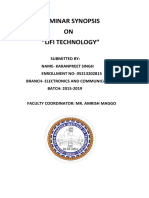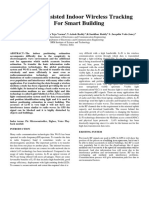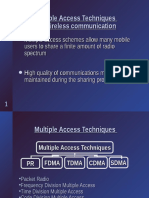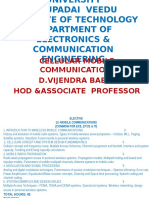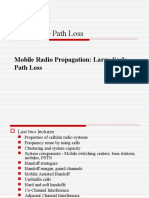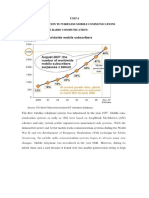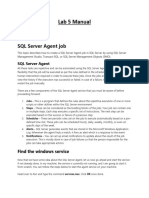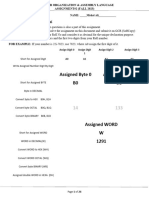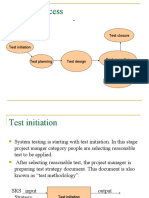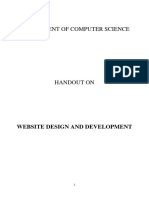International Journal of Applied Electronics (IJAE)
Volume 5, Issue 1, January-June 2024, pp. 1–5, Article ID: IJAE_05_01_001
Available online at https://iaeme.com/Home/issue/IJAE?Volume=5&Issue=1
ISSN Online : 2295-5177, Journal ID : 8550-6884
Impact Factor (2024) : 6.21 (Based on Google Scholar Citation)
© IAEME Publication
LiFi-BASED DATA TRANSMISSION BETWEEN
MOBILE DEVICES: A REVIEW
Deepika Agrawal
Department of Master of Computer Application,
Shri Ram Institute of Technology, Jabalpur M.P, India
Dr. Leena Jain
Department of Computer Applications, Global Group of Institutes,
Amritsar, Punjab, India
ABSTRACT
This paper presents a comprehensive review of LiFi-based data transmission
between mobile devices. It discusses the principles of LiFi technology and its potential
applications in mobile communication. The paper reviews recent advancements in LiFi
technology for mobile devices, including modulation techniques, receiver design, and
integration challenges. Furthermore, it explores the performance metrics, such as data
rate, latency, and reliability, of LiFi-based mobile communication systems. Finally, the
paper highlights future research directions and potential challenges in deploying LiFi
technology in mobile environments.
Keywords: Lifi, Mobile Devices, Modulation Techniques, Integration Challenges
Cite this Article: Deepika Agrawal and Leena Jain, Lifi-Based Data Transmission
Between Mobile Devices: A Review, International Journal of Applied Electronics
(IJAE), 5(1), 2024, pp. 1–5.
https://iaeme.com/Home/issue/IJAE?Volume=5&Issue=1
1. INTRODUCTION
LiFi, short for Light Fidelity, is a wireless communication technology that utilizes light waves
rather than radio frequencies to transmit data [1]. The fundamental principles of LiFi technology
revolve around the modulation of light emitted by light sources, typically LEDs (Light Emitting
Diodes), to encode data, which is then received and decoded by photodetectors [2]. Table 1
illustrates a comparison of speed transmission for several wireless technologies [3].
https://iaeme.com/Home/journal/IJAE 1 editor@iaeme.com
� Lifi-Based Data Transmission Between Mobile Devices: A Review
Table 1: Comparison of Speed for Different Wireless Technologies
Technology Speed
Li-Fi ~1 Gbps
Wi-Fi- IEEE 802.11n ~150 Mbps
IrDA ~4 Mbps
Bluetooth 3 Mbps
NFC ~424 Kbps
II. PRINCIPLES OF LIFI TECHNOLOGY
Here are the key principles of LiFi technology:
Light Modulation: LiFi systems modulate the intensity of light emitted by LED lamps at high
speeds. Binary data is encoded into these light signals by varying the intensity of light pulses.
Different modulation techniques like on-off keying (OOK) or pulse position modulation (PPM)
can be employed for encoding data onto the light waves [4].
Photodetection: Photodetectors, such as photodiodes or image sensors, receive the modulated
light signals and convert them back into electrical signals. These electrical signals are then
processed by the receiver to retrieve the transmitted data.
Line-of-Sight Communication: Unlike WiFi, which uses radio waves that can penetrate walls
and obstacles, LiFi requires a direct line of sight between the transmitter (LED) and the receiver
(photodetector). This characteristic provides inherent security benefits as the signal is confined
to the space illuminated by the light source.
High Bandwidth: Light waves have significantly higher frequencies than radio waves,
allowing for much greater data transmission speeds. LiFi can achieve data rates of several
gigabits per second, enabling ultra-fast wireless communication.
Interference-Free: LiFi operates in the visible light spectrum, which is free from
electromagnetic interference, making it suitable for use in environments where radio frequency
interference is a concern, such as hospitals, aircraft cabins, and industrial facilities.
III. POTENTIAL APPLICATIONS OF LiFi TECHNOLOGY IN MOBILE
COMMUNICATION
High-Speed Data Transfer: LiFi can enable high-speed data transfer between mobile devices
and access points, facilitating faster downloads/uploads, streaming of high-definition content,
and seamless multimedia experiences on smartphones and tablets.
Indoor Navigation and Localization: LiFi signals can be used for indoor positioning and
navigation applications, providing accurate location information within buildings where GPS
signals may be unreliable or unavailable. This could enhance navigation services for users in
shopping malls, airports, museums, and other indoor environments.
Augmented Reality (AR) and Virtual Reality (VR): LiFi technology can support immersive
AR and VR experiences on mobile devices by delivering high-bandwidth data streams for real-
time rendering of interactive content, gaming, and virtual simulations.
Secure Communication: LiFi's inherent security features, such as the limited range of light
propagation and the inability of light signals to penetrate walls, can be leveraged to establish
secure communication channels for mobile devices, protecting sensitive data from
eavesdropping and unauthorized access.
https://iaeme.com/Home/journal/IJAE 2 editor@iaeme.com
� Deepika Agrawal and Leena Jain
Smart Lighting Integration: LiFi can be integrated with smart lighting systems to provide
dual functionality, offering both illumination and wireless communication capabilities. This
integration could enable energy-efficient lighting solutions with embedded LiFi connectivity
for mobile devices, IoT devices, and other wireless gadgets.
Overall, LiFi technology holds great promise for enhancing mobile communication systems by
offering high-speed, secure, and interference-free wireless connectivity in various indoor
environments [5,6,7,8].
IV. RECENT ADVANCEMENTS IN LiFi TECHNOLOGY FOR MOBILE
DEVICES
Miniaturization of Components: Researchers are developing smaller and more efficient LiFi
transceivers and photodetectors suitable for integration into mobile devices, enabling seamless
and compact implementations.
Increased Data Rates: Advances in modulation techniques, such as orthogonal frequency-
division multiplexing (OFDM) and multiple-input multiple-output (MIMO) systems, are
enabling higher data rates in LiFi communication, meeting the growing demand for high-speed
data transmission on mobile devices.
Enhanced Mobility Support: New algorithms and protocols are being developed to support
mobility in LiFi networks, allowing mobile devices to seamlessly switch between different LiFi
access points without interruption.
Improved Reliability: Researchers are investigating methods to improve the reliability of LiFi
communication in challenging environments by mitigating interference from ambient light
sources and optimizing signal processing algorithms.
Integration with Existing Standards: Efforts are underway to standardize LiFi technology
and integrate it with existing wireless communication standards such as WiFi and cellular
networks, enabling seamless coexistence and interoperability with other wireless technologies
on mobile devices.
These advancements are driving the adoption of LiFi technology in mobile devices and
paving the way for its widespread deployment in various applications, including indoor
navigation, augmented reality, and high-density wireless networks.
V. PERFORMANCE METRICS OF LiFi-BASED MOBILE
COMMUNICATION SYSTEMS
Data Rate: The speed at which data can be transmitted over the LiFi channel, typically
measured in bits per second (bps) or megabits per second (Mbps). Higher data rates enable
faster file transfers, video streaming, and internet browsing on mobile devices.
Latency: The delay between the transmission and reception of data packets in the LiFi
communication system. Low latency is critical for real-time applications such as voice calls,
online gaming, and video conferencing on mobile devices.
Reliability: The ability of the LiFi communication system to maintain a stable and consistent
connection between mobile devices and access points, even in the presence of obstacles or
interference. Reliable communication is essential for uninterrupted data transmission and user
experience on mobile devices.
Coverage: The area within which mobile devices can establish a connection with LiFi access
points and maintain communication. Coverage depends on factors such as the range of the LED
light sources, the sensitivity of the photodetectors, and the presence of obstacles in the
environment.
https://iaeme.com/Home/journal/IJAE 3 editor@iaeme.com
� Lifi-Based Data Transmission Between Mobile Devices: A Review
Power Consumption: The amount of energy consumed by mobile devices during LiFi
communication, including both transmission and reception processes. Optimizing power
consumption is crucial for extending the battery life of mobile devices and enhancing their
usability.
Security: The level of protection against unauthorized access, eavesdropping, and data
interception in the LiFi communication system. Security measures such as encryption,
authentication, and key management are essential for safeguarding sensitive information
transmitted between mobile devices.
Interference: The extent to which ambient light sources or other wireless technologies interfere
with LiFi communication on mobile devices. Minimizing interference is important for
maintaining signal quality and reliability in various indoor environments.
By evaluating these performance metrics, researchers and engineers can assess the effectiveness
and suitability of LiFi-based mobile communication systems for different applications and
deployment scenarios.
VI. FUTURE RESEARCH DIRECTIONS AND POTENTIAL
CHALLENGES
Future research directions and potential challenges in deploying LiFi technology in mobile
environments include:
Standardization and Interoperability: Establishing standardized protocols and
interoperability between different LiFi devices and networks to ensure seamless integration and
compatibility with existing wireless technologies on mobile devices.
Mobility Support: Developing robust mobility management algorithms and handover
mechanisms to enable seamless transitions between different LiFi access points as mobile
devices move within indoor environments.
Outdoor Deployment: Investigating the feasibility of deploying LiFi technology in outdoor
environments and overcoming challenges such as interference from sunlight, weather
conditions, and longer communication ranges required for outdoor applications.
Integration with 5G and Beyond: Exploring synergies between LiFi and emerging wireless
technologies such as 5G and beyond to enhance coverage, capacity, and reliability in mobile
communication systems, particularly in dense urban areas and indoor environments.
Energy Efficiency: Designing energy-efficient LiFi transceivers and protocols to minimize
power consumption on mobile devices and extend battery life, thereby enhancing the usability
and practicality of LiFi technology in mobile environments.
Security and Privacy: Addressing security and privacy concerns related to LiFi-based mobile
communication, including authentication, encryption, and secure key exchange mechanisms to
protect sensitive data transmitted between devices.
Scalability and Deployment Cost: Developing cost-effective solutions for deploying LiFi
infrastructure in large-scale mobile networks and addressing scalability challenges associated
with managing a growing number of connected devices and users.
User Experience and Quality of Service: Improving user experience and quality of service
by optimizing performance metrics such as data rate, latency, reliability, and coverage in LiFi-
based mobile communication systems, thereby meeting the diverse needs of mobile users.
By addressing these research directions and overcoming potential challenges, LiFi
technology has the potential to revolutionize mobile communication and enable a wide range
of innovative applications in indoor environments, smart cities, transportation systems, and
beyond.
https://iaeme.com/Home/journal/IJAE 4 editor@iaeme.com
� Deepika Agrawal and Leena Jain
VII. CONCLUSION
LiFi-based data transmission holds great promise for revolutionizing mobile communication,
offering high-speed, secure, and reliable connectivity in indoor environments. With ongoing
advancements and research efforts, LiFi technology is poised to play a significant role in
shaping the future of mobile communication systems. This review has explored the potential of
LiFi-based data transmission between mobile devices, shedding light on its principles,
advancements, and applications.
REFERENCES
[1] S. Das, A. Chakraborty, D. Chakraborty and S Moshat, "PC to PC data transmission using
visible light communication." International Conference on Computer Communication and
Informatics (ICCCI), Coimbatore, India, (2017) January 5-7.
[2] M. Leba, S. Riurean and A. Ionica, “LiFi—The path to a new way of communication”, 2017
12th Iberian Conference on Information Systems and Technologies (CISTI), Lisbon, Portugal,
(2017) June 21-24.
[3] Nischay, “A Review Paper on Li-Fi Technology”, International Journal of Engineering
Research & Technology. (2017), vol.7, (23)
[4] Islim, M. S., & Haas, H. (2016). Modulation Techniques for Li-Fi. ZTE Communications.
[5] Shinichiro Haruyama Graduate School of System Design and Management, Keio University
(2012). Advances in Visible Light Communication Technologies. IEEE publications Optical
Communications (ECOC), 38th European Conference and Exhibition
[6] Krishna Prasad Pujapanda (2013). Lifi Integrated to Power-Lines for Smart Illumination Cum
Communication IEEE publication International Conference on Communication Systems and
Network Technologies.
[7] No of Al Abdulsalam, Raya Al Hajri, Zahra Al Abri, Zainab Al Lawati, and Mohammed M.
BaitSuwailam (2015). Design and Implementation of A Vehicle To Vehicle Communication
System Using Li-Fi Technology. IEEE publications International Conference on Information
and Communication Technology Research.
[8] Yunlu Wang, Stefan Videv and Harald Haas (2015). Dynamic Load Balancing with Handover
in Hybrid Li-Fi and Wi-Fi Networks. IEEE publications International Conference on
Information and Communication Technology Research.
Citation: Deepika Agrawal and Leena Jain, Lifi-Based Data Transmission Between Mobile Devices: A Review,
International Journal of Applied Electronics (IJAE), 5(1), 2024, pp. 1–5
Article Link:
https://iaeme.com/MasterAdmin/Journal_uploads/IJAE/VOLUME_5_ISSUE_1/IJAE_05_01_001.pdf
Abstract Link:
https://iaeme.com/Home/article_id/IJAE_05_01_001
Copyright: © 2024 Authors. This is an open-access article distributed under the terms of the Creative Commons
Attribution License, which permits unrestricted use, distribution, and reproduction in any medium, provided the
original author and source are credited.
This work is licensed under a Creative Commons Attribution 4.0 International License (CC BY 4.0).
✉ editor@iaeme.com
https://iaeme.com/Home/journal/IJAE 5 editor@iaeme.com




















